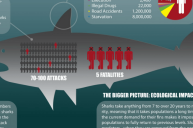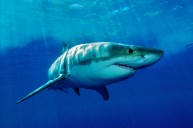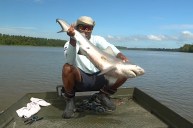The locations of the 1916 New Jersey shark attacks have not changed much in 100 years.
Arguably the most famous shark attacks in history are the 1916 Jersey Shore attacks that claimed the lives of four bathers on the East Coast and severely injured a fifth, sending waves of terror among beachgoers about a man-eater up and down the coastline that summer. These attacks are largely credited as the inspiration for Peter Benchley's hit book and the later Steven Spielberg film "Jaws."
The most notable part of the New Jersey shore attacks was the incident that happened in Matawan Creek on July 12, 1916 nearly a mile from the Atlantic ocean where a shark bit three people in the course of an afternoon in a fresh water creek.
Over 100 years after these famous attacks, YouTuber Mobile Instinct re-visits these brackish waters to see the creek where two people lost their lives. Seeing the real location where the attacks took place is enough to send a chill down the spine of anyone. It is easy to see where the modern fear of sharks came from while re-visiting this famous location.
The Jersey shark attacks happened at a time when tensions were already high. World War I was in full swing and the last thing many locals wanted to worry about was man-eating sharks swimming around close to shore. The attacks opened with a fatal attack on July 1 on 25-year-old Charles Vansant while he was swimming off Beach Haven, New Jersey. Lifeguards pulled him to shore, but Vansant suffered massive blood loss from the incident and died. Some experts now theorize the shark mistook him for a sea turtle or other natural prey item.
Five days later in Spring Lake, New Jersey just south of Asbury Park, 27-year-old Charles Bruder's legs were bitten off by a shark while he was swimming approximately 130 yards from the beach. Just like Vansant, he suffered massive blood loss and died before the lifeguards even got him back to the beach. The creek attacks happened on July 12. Young Lester Stillwell was pulled underwater first by a shark while swimming with his friends in the creek. His friends brought back help, which included 24-year-old Watson Stanley Fisher, who is still considered a hero in this story. Without thinking of his own safety, Fisher dove into the creek and helped to locate Stillwell's body. Unfortunately, Fisher was bitten while they tried to get the body to shore. He suffered massive blood loss and died shortly after.
The shark bit one more victim on the way back to the ocean, 14-year-old Joseph Dunn. He was the only person to survive the attacks. After the attacks, bounties were put out for the capture of the shark and dozens were killed in the weeks after. The most notable catch was a nine-foot great white that was discovered to have human remains in its stomach.
Even hearing that discovery, the attacks have been endlessly studied and researched. Most scientists today believe the shark responsible for the creek attacks was likely a bull shark because of their tolerance for freshwater. It is also believed that multiple sharks were likely responsible for the attacks and that the timing was more coincidence than anything else. Still, seeing these locations nearly 100 years later, and seeing how murky the water is, it really gets the imagination going. We can see why this incident is so well-remembered by New Jersey residents over 100 years later!
For more outdoor content from Travis Smola, be sure to follow him on Twitter and check out his Geocaching and Outdoors with Travis YouTube channels.
NEXT: PETA IS NOW GOING AFTER FISHERMEN
WATCH





